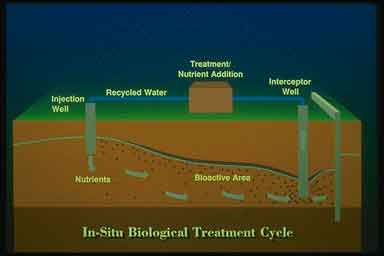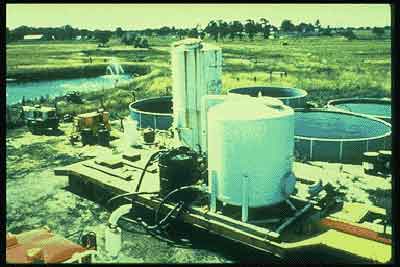
Leaking Underground Storage Tanks
Contaminants
Federal
UST Legislation
State Support
Cleanup Status
UST Definitions
Colorado
Oil Inspect Sec
UST Data
LUST
Anatomy
Corrosion
Leaks
Site Character
Remediation
Source
Groundwater
New Tanks
Installation
Monitoring
Anatomy of a LUST (continued)
Remediation of Contaminated Groundwater
Groundwater that comes into contact with the gasoline pools picks up contaminants. Groundwater can be remediated by a few active techniques and one notable passive technique, "natural attenuation."
Natural attenuation is the degradation of contaminants by naturally occurring processes. Most often, biological degradation of the contaminants by naturally present microorganisms is involved. At sites where the natural degradation of the contaminants is deemed to be sufficiently fast, the natural process is allowed to continue undisturbed.

Most sites, however, require some active intervention. Some of these remediation processes are illustrated in the following images.

At some sites, removal of "free product," the gasoline floating on the water table, is accomplished by suction pumping. Suction can be applied only to relatively shallow depths (theoretically, less than 32 feet).

With a pumping system that also lowers the groundwater table, a hydraulic barrier limiting groundwater migration can be created and both free product and contaminated groundwater can be extracted. Contaminated groundwater is cleaned on the surface, usually by air stripping. In air stripping, the contaminated water is injected with air in a tower. Volatile contaminants transfer from the water to the air. The air, now contaminated, is released to the environment where rapid dilution with clean air eliminates any hazardous exposure to the contaminants. The water is often treated further, usually by granular activated carbon. The activated carbon effectively adsorbs any remaining contaminants. Finally, the cleaned water is returned to the ground to maintain the water table and groundwater flow.

Continued on the next page...